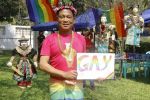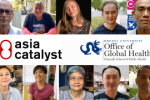
By Celina Su
In 2000, I began to work with a small, community-based project called the Burmese
Refugee Project (BRP) in northwest Thailand. Using a participatory
model of community development, the BRP helps over 100 Burmese Shan refugees in
northwest Thailand access education, health, and legal services. Through this
work, I learned that refugees are the victims of what public health researchers
call structural violence–physical and mental harm that results from unjust social, economic, and political
structures. Many of the prescriptions that would treat these ailments–such as a shared wheelbarrow so
that the refugees do not have to carry 50-kilo bags of rice on their shoulders,
and for the man above, sunglasses to treat pterygium (a scar on the eyes caused
by sun damage)–fall outside typical medical practice.
The Shan are an ethnic group in Burma (Myanmar). As many as half a million Shan have crossed
the eastern border into Thailand. While Shan people living in Thailand often
have a higher quality of life than they would have at home, they face legal and
economic disenfranchisement. Although official Thai policy guarantees Shan
access to basic social services, real-life protections of these rights in some
areas is spotty. The Thai government signed a migrant worker
repatriation treaty with the Burmese government in 2002, and since Thailand
never signed the 1951 United Nations Convention Relating to the Status of
Refugees, Thailand sometimes claims that the Shan are not refugees.
Many Shan people have work permits, but most earn just $1-$2 a day. By way of comparison, the
minimum wage for the average Thai worker in the rural northwestern provinces is
$5-6 a day. Nearly all of a Shan worker’s earnings go toward food, with housing
needs typically met by squatting on undeveloped or sharecropped land. In
addition, the Thai government charges an annual fee of $100 for each work
permit, which amounts to 3-4 months’ wages.
Most of the refugees in the community’s largest household cluster dig rocks from the
local river and haul them, in bins, to a local storage area. At the end of the
day, the refugees use their employer’s pick-up truck to transport the rocks to
a concrete-making facility. Because so much of the rock supply at the local
river has been diminished, the refugees must walk further away for rocks each
year.
In the community’s second-largest household cluster, most of the refugees work as sharecroppers or
as day laborers on farms. Because they do not receive adequate protective gear,
these workers are constantly exposed to dangerous pesticides in their work.
(Nearby households also smell the pesticides from inside their homes.) They
also lack recourse if employers refuse to pay them their promised wages. At
times, these employers threaten the refugees that employers will report them to
the Thai police if they demand back wages.
Other medical issues, such as the “noncompliance” of mothers in getting their babies
vaccinated, would also be resolved with more income and better transportation.
(Usually, if parents do not bring newborns for vaccinations as the local
hospital, the hospital workers go to the mother’s house for vaccination visits.
However, BRP community members live in impromptu huts, sometimes far from main
roads, and can be hard to find.)

Along similar lines, some of the BRP children are deemed “delinquent” in their
studies for two reasons. First, they do not always wear clean uniforms to
school, and many of their clothes and shoes had been worn to tatters. Second,
the children often drop out of classes during harvest season, to earn extra
income for their families. Because almost none of their parents have attended
even primary school, it is difficult for them to visualize future returns for
schooling, or to envisage that missed classes inhibit cumulative learning.
The BRP helps children to buy uniforms, as these costs are equivalent to several
months’ income for some households. Some of the parents who once resisted
sending their children to school also boast of their children’s high grades.
Finally, to the extent that BRP community
members exhibit “social pathologies,” they are the same ones apparent in other
marginalized communities–teen pregnancy, alcohol and drug dependence, and
gambling. In recent years, some employers have distributed methamphetamines
to workers to increase their productivity, unleashing a spiral of financial
dependence and substance abuse.
How can refugees combat
structural violence? The refugees in the BRP community are often too frightened
to advocate for themselves, and local Thai officials sometimes ignore refugees’
requests for protection from abusive employers, access to healthcare at
hospitals, or equal treatment at schools. When BRP social workers attempted
help refugee children born in Thailand to obtain birth certificates, one
District Officer retorted, “Did you know it is illegal to help anyone you’re
not related to?”
Further, because refugees
are fleeing conflict at home, the structural violence in Thailand can look
almost rosy by comparison. We are heartened when more and more refugee children
speak of the entitlements and rights afforded to others around them.
Celina Su is Associate Professor of Political Science at Brooklyn College.




